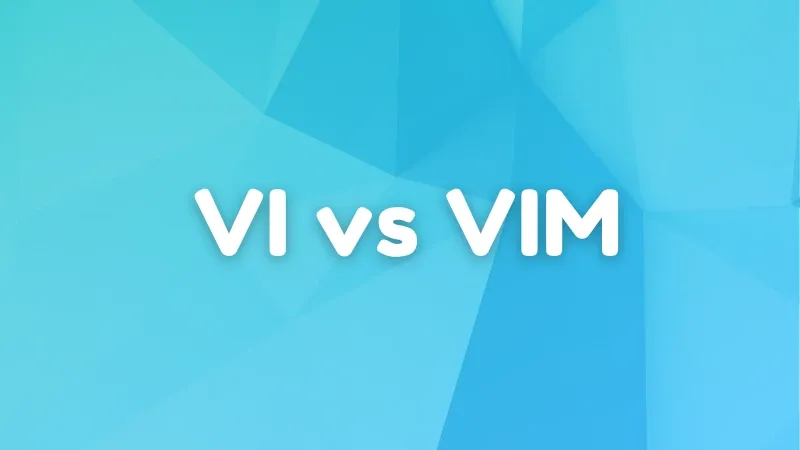
I have encountered situations where I had executed vi and it still runs Vim instead of the program that I had requested (Vi). That was just one part of the confusion.
I have seen people using Vi and Vim interchangeably, even though they are not the same editors.
Sure, many of you might know that Vim is an improved version of Vi (that is so obvious as Vim reads for Vi Improved) but there are still many differences and scenarios where you might want to use Vi over Vim.
Vi vs Vim: Why the confusion?
The confusion between Vi and Vim starts from their shared history and overlapping functionality. Vi, short for Visual Editor, was introduced in 1976 as part of the Unix operating system. It became a standard text editor on Unix systems, renowned for its efficiency and minimalism.
Vim, on the other hand, stands for Vi IMproved, and was developed in 1991 as an enhanced version of Vi, offering additional features like syntax highlighting, plugin support, and advanced editing capabilities.
Adding to the confusion is a common practice among Linux distributions: many create an alias or symlink that maps vi to Vim by default. This means that when users type vi in a terminal, they are often unknowingly using Vim instead of the original Vi. As a result, many users are unaware of where Vi ends and Vim begins.
While both editors share the same core functionality, Vim extends Vi with numerous modern features that make it more versatile for contemporary workflows. For most users, this aliasing works in their favour since Vim’s expanded feature set is generally more useful.
However, it has also led to widespread misunderstanding about what distinguishes the two editors.
Key differences between Vi and Vim
Now, let's take a look at the key differences between Vi and Vim:
| Feature | Vi | Vim |
|---|---|---|
| Undo Levels | Single undo | Unlimited undo and redo |
| Syntax Highlighting | Not available | Available for multiple programming languages |
| Navigation in Insert Mode | Not supported (requires exiting to command mode) | Supported (arrow keys work in insert mode) |
| Plugins and Extensibility | Not supported | Supports third-party plugins |
| Visual Mode | Not available | Allows block selection and manipulation |
| Tabs and Windows | Basic single-file editing | Supports tabs and split windows |
| Learning Curve | Simpler due to fewer features | Steeper due to additional functionality |
Is anything still better about Vi?
While I was not sure if anything was still positive about Vi, when I talked to some sysadmins and power users, I came across some surprising points which prove that Vi is still relevant:
- Minimalism: Vi’s simplicity makes it extremely lightweight on system resources. This can be advantageous on older hardware or when working in minimalistic environments.
- Universality: As a default editor on all POSIX-compliant systems, Vi is guaranteed to be available without installation. This makes it a reliable fallback editor when working on constrained systems or during system recovery.
- Consistency: Vi adheres strictly to its original design philosophy, avoiding potential quirks or bugs introduced by newer features in Vim.
Who should choose Vi?
You might wonder that based on the points I made, the userbase for Vi will be close to nothing but that is not true. I know multiple users who use Vi over anything modern.
Here are groups of people who can benefit from Vi:
- System administrators on legacy systems: If you work on older Unix systems or environments where only basic tools are available, learning Vi is a dependable choice.
- Minimalists: Those who value simplicity and prefer minimal resource usage may find Vi sufficient for their needs.
Who should choose Vim?
For most users, however, Vim is the better choice:
- Learning the basics: Beginners aiming to understand core text-editing concepts might benefit from starting with Vim as the lack of features in Vi could be even more overwhelming.
- Developers and programmers: With features like syntax highlighting, plugin support, and advanced navigation tools, Vim is ideal for coding tasks.
- Power users: Those who require multilevel undo, visual mode for block selection, or split windows for multitasking will find Vim indispensable.
- Cross-platform users: Vim’s availability across multiple platforms ensures a consistent experience regardless of the operating system.
In fact, unless you’re working in an environment where minimalism is critical or resources are highly constrained, you’re almost certainly better off using Vim. Its additional features make it far more versatile while still retaining the efficiency of its predecessor.

Vi vs Vim: which one should I use?
Conclusion
Vi and Vim cater to different needs despite their shared lineage. While Vi remains a lightweight, universal editor suitable for basic tasks or constrained environments, Vim extends its capabilities significantly, making it a powerful tool for modern development workflows.
The choice ultimately depends on your specific requirements—whether you value simplicity or need advanced functionality.
Which one do you use? Let us know in the comments.


